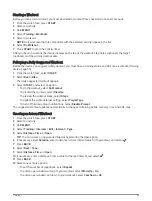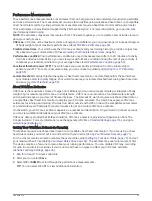
Performing a Guided Test to Determine Your Lactate Threshold
This feature requires a Garmin chest heart rate monitor. Before you can perform the guided test, you must put
on a heart rate monitor and pair it with your device (
Pairing Your Wireless Sensors, page 71
).
The device uses your user profile information from the initial setup and your VO2 max. estimate to estimate
your lactate threshold. The device will automatically detect your lactate threshold during runs at a steady, high
intensity with heart rate.
TIP: The device requires a few runs with a chest heart rate monitor to get an accurate maximum heart rate value
and VO2 max. estimate. If you are having trouble getting a lactate threshold estimate, try manually lowering
your maximum heart rate value.
1 From the watch face, select START.
2 Select an outdoor running activity.
GPS is required to complete the test.
3 Hold MENU.
4 Select Training > Lactate Threshold Guided Test.
5 Start the timer, and follow the on-screen instructions.
After you begin your run, the device displays each step duration, the target, and current heart rate data. A
message appears when the test is complete.
6 After you complete the guided test, stop the timer and save the activity.
If this is your first lactate threshold estimate, the device prompts you to update your heart rate zones based
on your lactate threshold heart rate. For each additional lactate threshold estimate, the device prompts you
to accept or decline the estimate.
Training Status
These measurements are estimates that can help you track and understand your training activities. The
measurements require a few activities using wrist-based heart rate or a compatible chest heart rate monitor.
Cycling performance measurements require a heart rate monitor and a power meter.
These estimates are provided and supported by Firstbeat Analytics. For more information, go to
NOTE: The estimates may seem inaccurate at first. The watch requires you to complete a few activities to learn
about your performance.
Training status: Training status shows you how your training affects your fitness and performance. Your
training status is based on changes to your training load and VO2 max. over an extended time period.
VO2 max.: VO2 max. is the maximum volume of oxygen (in milliliters) you can consume per minute per kilogram
of body weight at your maximum performance (
About VO2 Max. Estimates, page 53
). Your watch displays
heat and altitude corrected VO2 max. values when you are acclimating to high heat environments or high
altitude (
Heat and Altitude Performance Acclimation, page 57
).
Training load: Training load is the sum of your excess post-exercise oxygen consumption (EPOC) over the last 7
days. EPOC is an estimate of how much energy it takes for your body to recover after exercise (
).
Training load focus: Your watch analyzes and distributes your training load into different categories based on
the intensity and structure of each activity recorded. Training load focus includes the total load accumulated
per category, and the focus of the training. Your watch displays your load distribution over the last 4 weeks
(
).
Recovery time: The recovery time displays how much time remains before you are fully recovered and ready for
the next hard workout (
).
56
Appearance






























